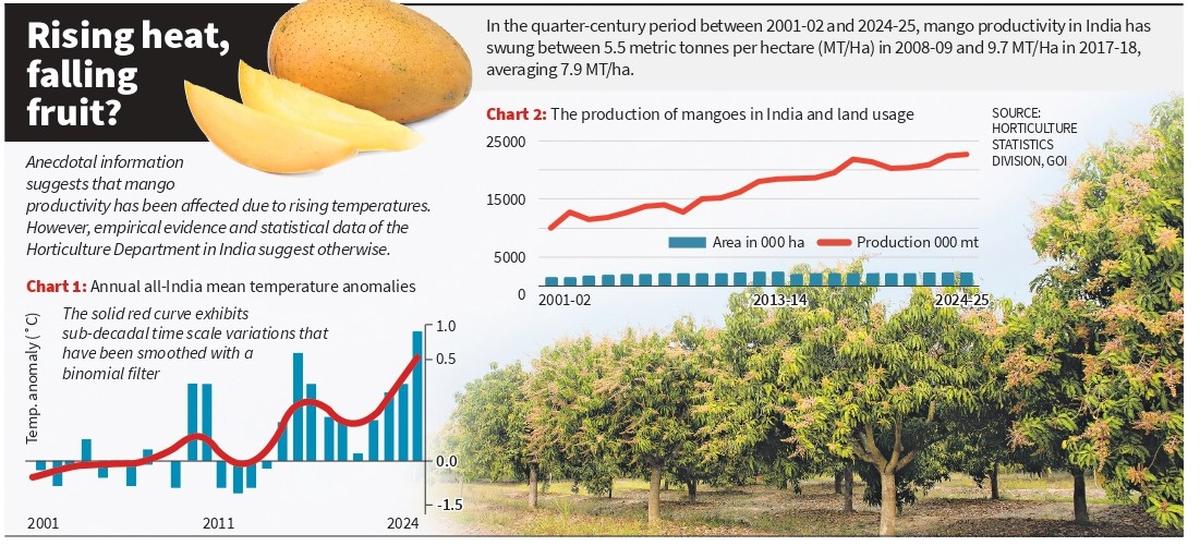High temperature and mango production|explained

On April 10, jelly perched on a mango tree in the outskirts of Kumarakom, Kerala. Image source: PTI
Story so far:
“The amount of mango harvest has dropped. Mangoes no longer taste sweet. Mangoes are expensive. Mangos arrive too early in the market. Mango pickles continue throughout the year. Mango plants have been some anecdotal conversations about mangoes in India over the past few years. Is this related to higher temperatures?
What is a threat?
According to the 2024 climate survey by the Indian Meteorological Agency (IMD), “the country’s annual average surface air temperature in 2024 is higher than the 1991-2020 average. So, making 2024 the warmest year since 1901.” IMD data suggest that the past 12 years are warmer than previous years, which ignores statistical norms, which are cooler than others.
Anecdotal information shows that mango productivity is affected due to rising temperatures. Researchers in Egypt published a paper on “climate change and mango production,” saying: “In the near future, agriculture and mango production, especially mango production, will face serious threats from climate change.”
What is the report from the orchard?
However, empirical evidence and statistical data recommendations from the Horticulture Department in India. During the quarter century between 2001-02 and 2024-25, India’s mango productivity was between 5.5 tons per hectare (MT/HA) in 2008-09, and 9.7 tons/ha in 2017-18, with an average of 7.9 tons/ha. In 2024-25, it is estimated to be 9.4 tons per hectare. This is higher than the other two major producers in China (8.74 tons/hectare) and Thailand (8.36 tons/hectare).
According to the Agricultural Market Intelligence Centre at Jayashankar Telangana National Agricultural University in Hyderabad, the region under mango cultivation has increased. During the 2023-24 period, the mango area in India increased by 2.34% to 2.401 million hectares (5.934 billion acres), with a production of 224.23 billion tons (as estimated for the third advance) of 23.46 lakh hectares (57.46 lakh Hectares (57.46 lakh Hectares (57 lakh hectares), in 57.46 lakh hectares (57 lakh hectares) (57.7 lakh,

Will heat waves affect trees?
While the effects of higher temperatures on the human body are being studied, the jury addressed the environmental stresses experienced by trees and plants. “Higher temperatures can cause the fruit drop in mangoes, early ripening, sunshine and uneven ripening.
The mango factory has specific weather requirements since it began to appear at the end of winter. Pollination must be performed before the fruit is established. The germination stage and fruit setting stage are very long. A mango farmer said that the weather pattern with strong heavy rain and long dry spells is changing the timing of mango plants germinate and bloom. Although rain, hail, or wind destroys and affects productivity at any of these stages, the resilience of mangoes and higher productivity is associated with genetic diversity.
Is genetic mutation important?
Indian researcher led by Rajdeep Haldar, who published a paper International Journal of Advanced Biochemistry Research In March 2024, similar conclusions were drawn on mango production and higher temperatures in the region. He linked it to genetic diversity.
“There are multiple reasons to remain optimistic about the future of mango production and agriculture. These species have great adaptability to the surrounding environment. Mangoes have physiological mechanisms that allow them to adjust and thrive in diverse and demanding environments. Substantial genetic diversity provides multiple advantages for the development of traditional or modern reproductive technologies to adapt them to certain environments and moderate environmental changes. The research paper says it is compatible with the effects of global climate change, including drought and high temperatures.”
publishing – April 30, 2025 at 08:30 am IST




